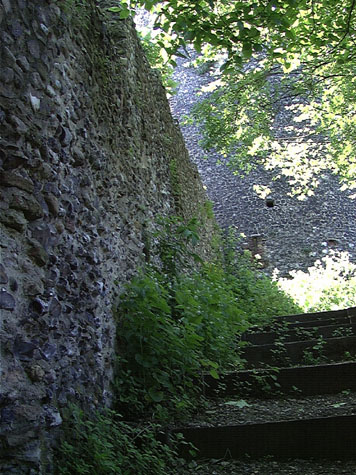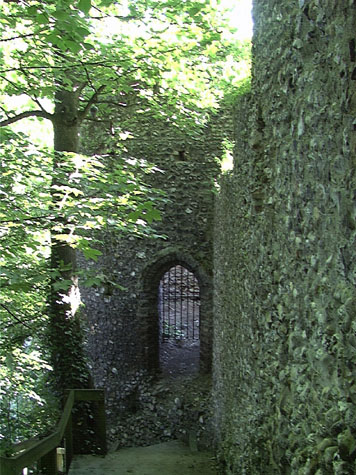
[24] View on the inside of the wall looking up towards the Black Tower

[25] The doorway into the lower tower.
|
Conservation Plan
The wall and lower tower and the setting here is of considerable
value. Any scheme to enhance the setting or any proposal to draw
more visitors to the monument must be co-ordinated with any plans
for the Black Tower above and proposals for the King Street Walls
and the Boom Towers below. Any scheme should try, in the medium
to long term, to pull together this south section of the defences
which from the east Boom Tower to Ber Street runs for almost 500
metres.
The present setting:
The wall and tower are set on a ridge running down from the top
of Carrow Hill towards the site of Conisford Gate on King Street.
On the city side of the wall is a steep wooded slope with a relatively
dense planting of young spindly trees. The pathway down from the
Black Tower to the lower tower is hard against the wall for most
of the way with steep steps with rough timber risers and gravel
treads and an outer wooden rail. All this is in good condition as
are most of the people who attempt to climb up it.
[24 & 25]
On the outer side of the defences a steep slope runs down to
Carrow Hill. This was, in effect the outer ditch of the wall, and
was man made in part by quarrying. The slopes are now wooded but
with steep steps and pathways providing a route from the outer side
of the Black Tower skirting close to the wall initially but then
cutting out to Carrow Hill. From there a steep run of steps zig
zags back into the trees, down to the outer side of the lower tower
and from there cuts through the line of the wall to run down to
King Street against the inner side of the wall.
Landscape report by Christine Boswell:
From the Black Tower to the lower tower the Breedon gravel path
continues. To the north occasional glimpses of views across the
valley can be seen between the tree canopy of the growth on the
lower slopes. The path is stepped and very steep. A small section
of steps adjacent to the lower tower are all timber and when wet,
very slippery. The whole walk is very dark from the overhanging
trees.
There are terraced houses at the bottom of the walk to the north
which are shielded by the tree growth. Their privacy should remain.
The last section of the walk approaching King Street narrows before
it widens to the pavement. Again it is very dark and unwelcoming.
There are not any signs or information boards indicating where the
path leads to.
Recommendations:
- The nettle-covered margins should be removed and replanted
with evergreen ground cover (eg. Lamium
maculatum).
- The trees to the northern slopes should be selectively thinned
to provide views at selective stopping points across the valley
while retaining the privacy of the houses below.
- The timber steps should be covered with wire netting to provide
grip in wet weather.
- The whole of the pathway should be lit with discreet low level
lighting for safety.
- At each path entrance to the walk, there should be a map which
illustrates the route and noting points of interest.
- The south facing banks should be cleared of all weed growth and
replanted with flowering ground cover, species roses and flowering
woodland shrubs to provide a colourful woodland backdrop and base
to this section of the City Walls.
Potential medium or long-term improvements recommended for the
surroundings:
See the report on the Black Tower
Archaeological impact assessment:
Archaeological excavations on this section are not a priority
and the wall and tower are not under threat. However, any work on
consolidating or underpinning the wall, if that should be necessary,
could provide information about the footings of the wall and details
about the form of the base of the tower on the outer side. Elsewhere,
the towers appear to have stepped outwards at the base on the ditch
side, well below the internal ground level, with a chamfer at about
soil level on the slope of the ditch.
The substructure of the lower tower must have been quite an engineering
achievement. As there is no indication that the massive balk of the
tower has moved down the slope, it is possible that a solid platform
was cut into the hillside. Archaeological excavations might also
determine how much of the ridge and the ditch are part of the natural
topography of the hillside. There were extensive medieval quarries
to the south and along the side of the river valley to the north so
much of the ridge and ditch may actually not be natural.
As elsewhere, the gate is mentioned in documents considerably
before the accepted date for the construction of the flint wall and
towers ... the earliest known reference to Conisford Gate is in 1175.
Again, this suggests the possibility that an earlier bank and ditch
preceded the surviving wall on the same line and it also means that
the towers may pre date the wall if only by a few years. Archaeological
digs across the line of the wall below the tower and examination of
the footings if the wall above the tower has to be underbuilt on the
inner side could provide vital evidence to tighten up the
interpretation of this section of the wall.
Conservation Report Summary with Recommendations for Action
1. Immediate attention
- No immediate repairs required
2. Requires regular monitoring
- Monitor the base of the wall on the inner north side between
the Black Tower and the lower tower to ensure that water penetrating
from above or water draining past is not undercutting the wall.
If movement or partial collapse is observed then the wall must be
underpinned and the earth on the inner side should be banked up to
protect the footings. The bank would have to be revetted on outer
side and the steps would have to be rebuilt.
3. Long term conservation
- Re-mortar flints and bricks along wall top
- Re point around doorway into lower tower
Improvements to the setting
Priority
- Cut back all overhanging branches of trees on inner or north
side of the wall. Cut back branches overhanging the wall from the
south side. This is to bring more sunlight through to the path,
to keep down mould growth on the steps and to stop heavier branches
that move in the wind pushing against or knocking the wall top
Long term
- Thin out trees on both sides with a carefully planned scheme to
encourage appropriate growth of what then become key or specimen
trees but open up at least some clear views of the wall from below
from Carrow Hill. Under plant with low-growing woodland plants
- Cut sight lines down through trees on north slope to create
views of the river
- Re establish walks and steps through the Wilderness to link this
area to the small park around the ruins of St Peters Church.
BIBLIOGRAPHY:
Blyth, G.K., The Norwich Guide and Directory (London: R. Hastings;
Norwich: Josiah Fletcher, 1842)
Collins, Arthur E., The Walls of Norwich (City and County of Norwich,
Norwich: Jarrold & Sons, 1910)
Hudson, William, and Tingey, John C., The Records of the City of
Norwich,
vol. II (Norwich & London: Jarrold & Sons, 1910), pages 216-22, Extract
from The Old Free Book
DOCUMENTARY REFERENCES:
We have found no medieval documents relating to the construction of this tower
HISTORIC ILLUSTRATIONS:
Norwich Castle Museum and Art Gallery:
Harcourt, Bosworth W., King St Gates, September 18 1905, NWHCM 1922,135.BH46: F
|
